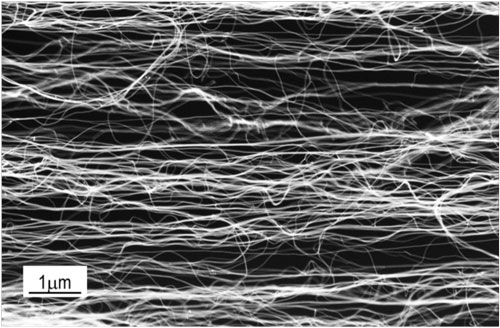| Posted: Dec 18, 2014 | |
Carbon nanotubes enable new way of sound generation |
|
| (Nanowerk Spotlight) Carbon nanotube assemblies enabled design of a hybrid thermo-electromagnetic sound transducer with unique sound generation features that are not available from conventional diaphragm and thermo-acoustic speakers. | |
| Conversion of alternating electrical current (AC) into acoustic signal is quite common multimedia task. It can be accomplished using a conventional diaphragm loudspeaker that is often called electromagnetic (EM) sound transducer. In this device sound waves are created by spatial oscillations of a diaphragm driven by an electromagnetic voice coil. | |
| Less common thermoacoustic (TA) sound generation was discovered more than 100 years ago and used in first telephones (thermophones). Acoustic signal in such transducer is produced thermally as a result of heating the air with a fast heater. | |
| The thermoacoustic field has benefited from carbon nanotube and graphene heaters that substantially improved performance of the TA speaker. Because of small heat capacity and excellent coupling with surrounding air, the latter produced intense sound in a broad frequency range that made it an attractive option for the design of advanced sound generation and active noise cancellation systems. | |
| Another way of sound generation enabled by carbon nanotube assemblies has recently been reported in the Journal of Applied Physics ("Thermo-electromagnetic sound transducer based on carbon nanotube sheet"). | |
 |
|
| SEM image of multi-walled carbon nanotube sheet used for thermo-electromagnetic sound transducer. (Image: Mikhail Kozlov, University of Texas at Dallas) | |
| This paper describes a hybrid thermo-electromagnetic sound transducer (TEMST) fabricated using highly porous multi-walled carbon nanotube sheet that was placed in the proximity of a permanent magnet. Upon electrical AC excitation, thermal response of the material is combined with diaphragm-like sheet oscillations induced by the electromagnetic action of the Lorentz force. | |
| Unlike conventional diaphragm loudspeaker, acoustic spectrum of the TEMST device consists of a superposition of TA and EM responses that can be altered by applied bias voltage. Variation of bias voltage changes spectral intensity and spatial distribution of generated sound. | |
| In particular, propagation direction of the sound can be reversed by switching bias polarity that somewhat resembles voltage-controlled acoustic reflection. Such uncommon behavior was explained by interference of the two contributions being beneficial for diverse sound management applications. | |
| It was found also that amplitude of first TEMST harmonic changes a lot with applied magnetic field, while the second one remains almost field independent. This unusual feature is convenient for magnetic sensing similar to that enabled by Lorentz force magnetometers. The magnetic field detection in the TEMST device is facilitated by the audio sensing system. | |
| Finally, the ability of comparison of EM and TA responses can be helpful for analysis of interaction of the material with air, porosity and permeability evaluation. | |
|
By Mikhail E. Kozlov, University of Texas at Dallas
|
|
|
Become a Spotlight guest author! Join our large and growing group of guest contributors. Have you just published a scientific paper or have other exciting developments to share with the nanotechnology community? Here is how to publish on nanowerk.com. |
|
